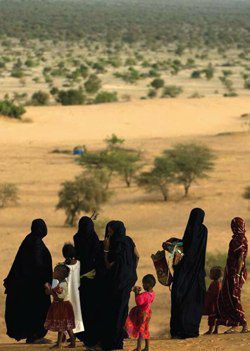 A report released last week from Care International, the United Nations University, and Columbia University entitled In Search of Shelter: Mapping the Effects of Climate Change on Human Migration and Displacement (pdf)
A report released last week from Care International, the United Nations University, and Columbia University entitled In Search of Shelter: Mapping the Effects of Climate Change on Human Migration and Displacement (pdf)
The report states impacts of climate change are already causing migration and displacement among the most vulnerable human populations in the developing world and on low-lying island nations.
It isn’t possible yet to assess the exact number of people that will be displaced by climate change, but the report asserts that by mid-century the scale of the migration will be greater than anything seen before in human history. With consequences for security and political stability reaching across the globe.
The global scale of the challenge therefore requires a global response to avert tragedy for billions of people, the report says.
Key findings (from the report’s executive summary):
- Climate change is already contributing to displacement and migration. Although economic and political factors are the dominant drivers of displacement and migration today, climate change is already having a detectable effect.
- The breakdown of ecosystem-dependent livelihoods is likely to remain the premier driver of long-term migration during the
next two to three decades. Climate change will exacerbate this situation unless vulnerable populations, especially the poorest,
are assisted in building climate-resilient livelihoods. - Disasters continue to be a major driver of shorter-term displacement and migration. As climate change increases thefrequency and intensity of natural hazards such as cyclones, floods, and droughts, the number of temporarily displaced
people will rise. This will be especially true in countries that fail to invest now in disaster risk reduction and where the
official response to disasters is limited. - Seasonal migration already plays an important part in many families’ struggle to deal with environmental change. This is likely to become even more common, as is the practice of migrating from place to place in search of ecosystems that
can still support rural livelihoods. - Glacier melt will affect major agricultural systems in Asia. As the storage capacity of glaciers declines, short-term flood risks increase. This will be followed by decreasing water flows in the medium- and long-term. Both consequences of glacier melt would threaten food production in some of the world’s most densely populated regions.
- Sea level rise will worsen saline intrusions, inundation, storm surges, erosion, and other coastal hazards. The threat is
particularly grave vis-à-vis island communities. There is strong evidence that the impacts of climate change will devastate
subsistence and commercial agriculture on many small islands. - In the densely populated Ganges, Mekong, and Nile River deltas, a sea level rise of 1 meter could affect 23.5 million
people and reduce the land currently under intensive agriculture by at least 1.5 million hectares. A sea level rise of 2 meters would impact an additional 10.8 million people and render at least 969 thousand more hectares of agricultural land unproductive. - Many people won’t be able to flee far enough to adequately avoid the negative impacts of climate change—unless they receive support. Migration requires resources (including financial, social, and political capital) that the most vulnerable populations frequently don’t have. Case studies indicate that poorer environmental migrants can find their destinations as
precarious as the places they left behind.



‘Climate Refugees: Mapping the Effects of Climate Change on Human Migration and Displacement’- well its a nice topic ,
In 1993, the prediction that there would be 150 million environmental refugees by the end of the 21st century, as forecast by Norman Myers, further fuelled the fear of mass migrations (Myers 2003). In the review “Population and Environment” this respected environmentalist wrote, four years later, ” the issue of environmental refugees (…) promises to rank as one of the foremost human crises of our times” (Myers 1997, p. 175). Environmental change has a multiplier effect on other drivers of migration, such as economic hardship and crop failure. Yet terms such as “environmental refugees” and “climate refugees” may cause more problems than they solve. Neither category has status under international law. In the case of small island nations, there is an additional obstacle: If a whole state becomes submerged or uninhabitable, and there is no prospect of return, temporary refuge will not be enough. Bogumil Terminski from HEI argued in “Environmentally Induced Migrations” that there is a huge conceptual difference between “environmental migrants” and “environmental refugees”. According to this author environmental migrant is a persons making a short-lived, cyclical, or longerterm change of residence, of a voluntary or forced character, due to specific environmental factors. Environmental refugees, therefore, are people compelled to spontaneous, short-lived, cyclical, or longer-term changes of residence due to sudden or gradually worsening changes in environmental factors important to their living, which may be of either a short-term or an irreversible character. As the evidence for global environmental change has accumulated over the past decade, academics, policymakers, and the media have given more attention to the issue of “environmental refugees.” A major concern is whether environmental change will displace large numbers of vulnerable people in the developing world, particularly from rural areas where livelihoods are especially dependent on climate and natural resources. A widely cited article estimated that more than 25 million people were displaced by environmental factors in 1995. Myers argued that the causes of environmental displacement would include desertification, lack of water, salination of irrigated lands and the depletion of bio-diversity. He also hypothesised that displacement would amount to 30m in China, 30m in India, 15m in Bangladesh, 14m in Egypt, 10m in other delta areas and coastal zones, 1m in island states, and with otherwise agriculturally displaced people totalling 50m (Myers & Kent 1995) by 2050.
Source: Global Warming is Real